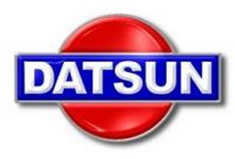Published 2008 Updated 2016
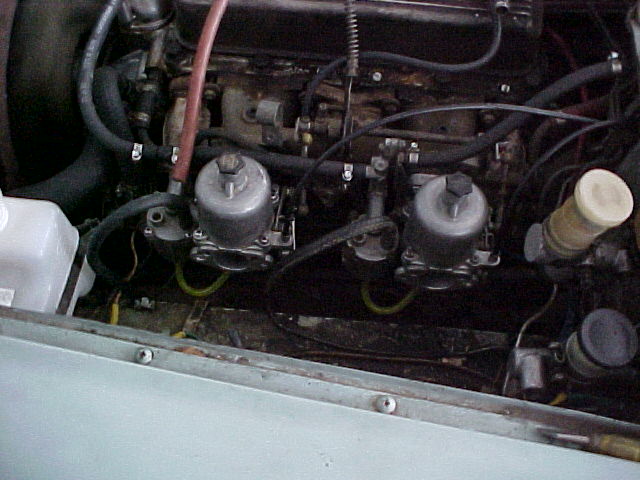
Setting up and adjusting SU/Hitachi carbs on the Datsun Roadster
by Keith Williams
Updated 04/03/2016
First things first.
In order for the SUs to work properly the ignition timing and valve clearance must be correct.
On the 1600 (R16) engine two different distributors were used. The point gap for both is .018 to .022 or .45mm to .55mm. The dwell angle for the Hitachi distributor is 50 - 54 degrees. The dwell angle for the Mitsubishi distributor is 56 - 61 degrees. On the 2000 (U20) engine the dwell is 49 - 55 degrees.
The 1600 (R16) was fitted with the early mechanical advance curve of 15 crank degrees and a late (smog) 30 degree curve. The early distributor requires an initial timing setting of 16 degrees before top dead center. The late distributor is set to zero degrees before top dead center. Distributors were often swapped so it is best to check to see which on is in your car. A way to do that is, after disconnecting the vacuum advance, set the timing to TDC. Rev up the engine watching the timing mark. The early distributor will only advance 15 degrees. The later will advance 30 degrees. For a final check after setting the timing hook up the vacuum advance, rev up the engine and check the total advance. It should be about 36 degrees maximum. On the SU equipped 2000(U20) the timing should be set to 16 degrees BTDC.
Valve adjustment is very important. The amount of fuel/air mixture each cylinder draws is affected by when the valves open and close and that is affected by the clearance setting. For the 1600(R16) all valves ate set to .017 or .43mm with the engine warmed up. The 2000(U20) intake valves are set to .008 or .2mm and the exhaust to .012 or .3mm. Again with the engine warmed up.
Insure that there is some slack in the throttle cable. The cable housing grows longer as it heats up. If there is not enough slack the idle speed will get higher as the engine warms up.
Service screw?
This is the “service screw” it’s only use it to raise the engine speed while adjusting the SUs. In normal operation it is backed off until it does not touch.
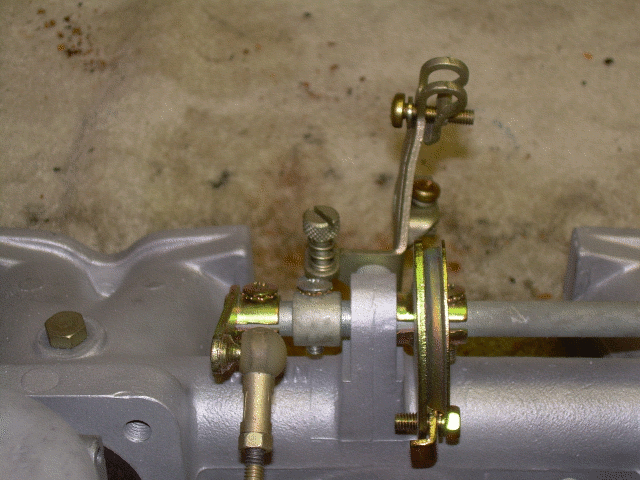
The service screw found on the 1600(R16).
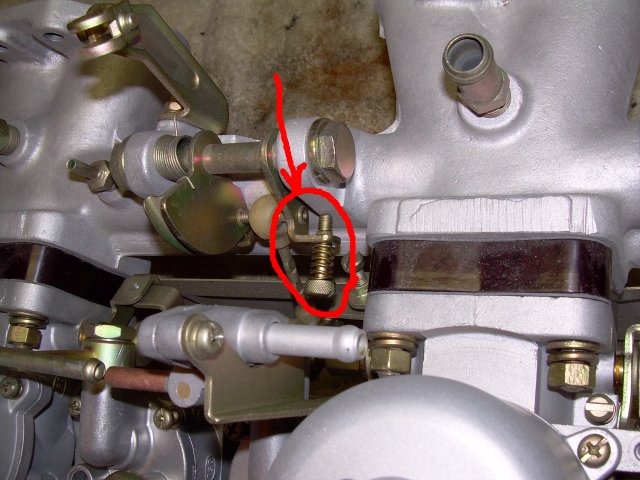
This service screw design was introduced with the 67.5 2000. This engine did not have the thermo fuel valve and the design worked well. In 1968 the thermo fuel valve was introduced and there is an interference problem between the screw and the valve. Some of the screws were made shorter to address this problem. The shorter screws are too short to work properly. A small folded up piece of paper between the screw and the manifold will allow it to work. When you are done using the screw it needs to be screwed in as far as it will go without touching the manifold and the screw head to thermo valve clearance checked. If they hit it can cause the throttle to stick open.
Idle air flow synchronization
With the service screw backed off and some slack in the throttle cable the dog bones should have some play. This looseness allows the idle adjustment screws to control the throttle butterfly valves. If either throttle is being pushed closed or pulled open by the dog bone at idle, adjust the length of the dog bone.

Here is the front SU idle air flow adjustment screw for the 1600. This screw opens the butterfly valve a small amount.
The 1600 rear SU idle air flow adjustment screw is the same as the front. If the dog bones are set up properly and the service screw is backed off the two idle adjustments should act independently.
The 2000 idle adjust screws. The 2000 SUs are mirror image of each other so the screws are on the opposite side.
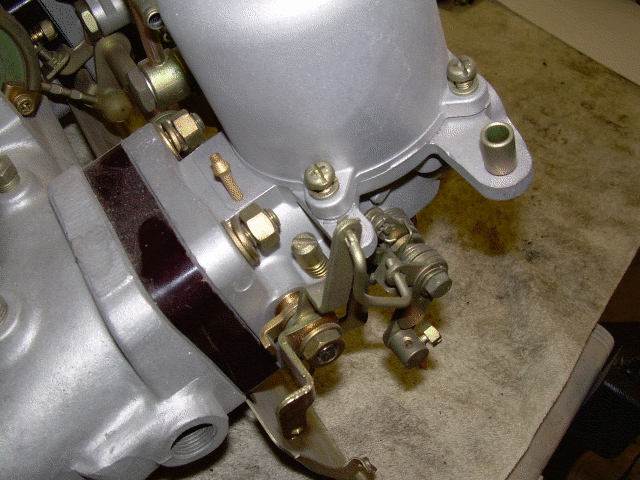
Front 2000 SU idle adjustment
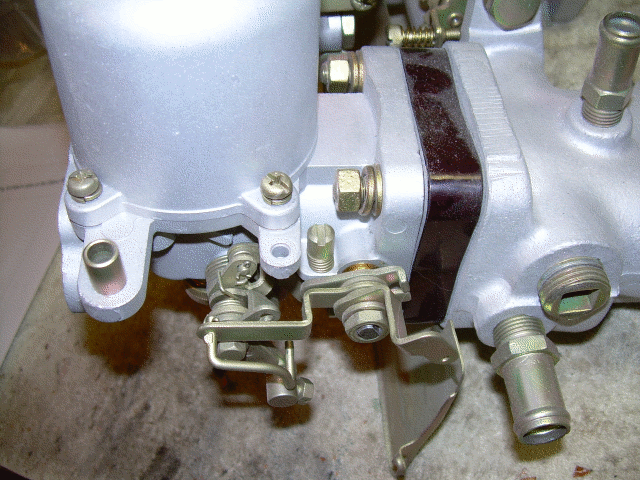
Rear 2000 SU idle adjustment
High speed air flow synchronization
Here is the dog bone the 1600 has two of these turnbuckles to adjust the high speed synchronization of the carbs.
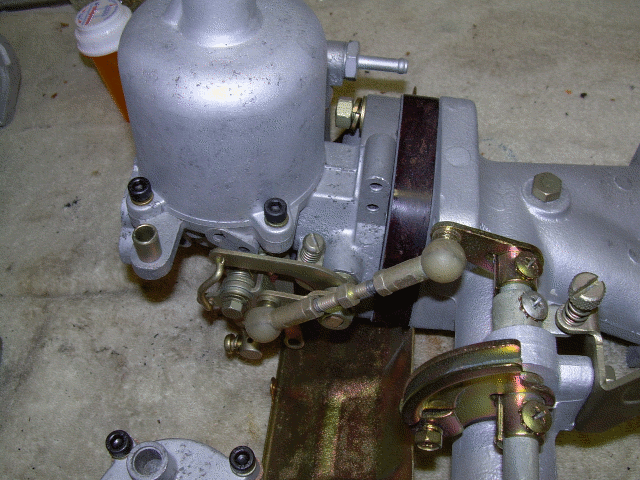
The dog bones are turnbuckles. It is not necessary to remove them to change the length. Loosen both lock nuts and turn the center section to vary the length. After the initial setup is done pick one dog bone to make future adjustments. This prevents them from getting progressively longer or shorter as you switch back and forth. I normally adjust the one closest to the firewall.

The high speed synchronization screw on the 2000 SUs. This screw should be a very snug fit to prevent it from moving from vibration. A properly fitting screw driver is essential.
Air Flow Balancing
By measuring the air flow through each carb with a UNI-SYN or similar tool the front and rear air flows are set to be the same.
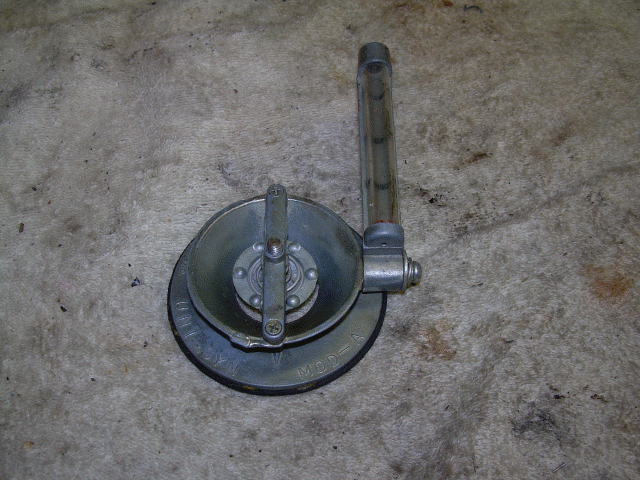
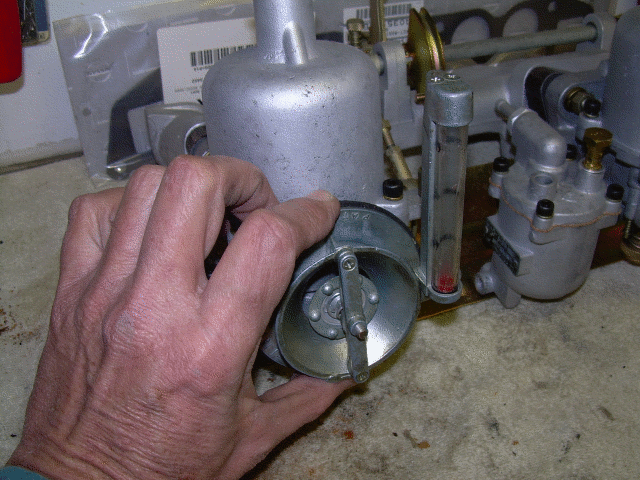
This is the UNI-SYN. A good basic tool that gets the job done.
The idle air flow is balanced first. The Uni-Syn is adjusted so that the ball rises about half way up the tube. By adjusting the idle speed screws the idle speed is maintained about 600-700 RPM and the flow is adjusted so that the ball raises the same on both carbs.
Once the idle air flow is balanced the service screw is used to raise the engine speed to 2000 RPM. The Uni-Syn is adjusted so that the ball rises about half way up the tube at this higher speed. Using the dog bone on the 1600 or the balance screw on the 2000 the flow is balanced so that the ball raises the same amount on both carbs.
When the high speed is balanced, back off the service screw and recheck the idle air balance. The two adjustments should be independent but sometimes it takes a little fiddling to get all the linkages set up properly.
Mixture adjustment
Once everything else is done it is time to adjust the fuel/air mixture. The mixture adjustment is done with the large knobs on the bottom of the carbs.

This knob raises and lowers the metering nozzle. Screwing the knob down (clockwise from the top of the carb) lowers the nozzle and richens the mixture. Turning the knob up (anticlockwise from the top of the carb) raises the nozzle and leans the mixture.>
To set the carb mixtures first raise the engine speed to 2000 RPM with the service screw. The idle and high speed mixture both are set with the same knob. As the car is usually driven with the engine at speed and spends little time at idle I prefer to set the mixture at the higher speed. There are two methods to set the mixture knobs. The first is to use a service tach to monitor the engine speed. Adjust each carbs mixture knob to maximize the engine RPM. If the engine speeds up too much lower the speed with the service screw. The other is to raise and lower the slides to test the mixture. Reach down the carb mouth and lift the slide a little with your fingernail. Try to stay out of the air flow going under the piston. Raising the piston allows more air in and reduces the vacuum at the nozzle. This leans this carb. If the engine speed rises as the slide is raised a little that carb is rich. The adjustment knob for that carb needs to be turned up (anticlockwise). With a little practice you can push down on the face of the slide and lower it a little. This reduces the air and increases the vacuum at the nozzle. This richens the carb. If the engine speeds up that carb is lean. The adjustment knob needs to be turned down (clockwise). Once the mixture is correct either raising or lowering the slide will slow the engine speed. With either method this will get you very close to the ideal mixture. This is where the idle speed is adjusted to be between 600 and 700 RPM. Remember, to raise or lower the idle speed both adjustment screws need to be changed and the air flow rebalanced. Once this is done recheck the high and low speed air flow balance. For the final adjustment the car needs to be driven and the spark plugs checked. Starting with fresh plugs. If the plugs are getting black from carbon that carb is a little rich. Lean it about 1/4 turn. If at a constant throttle cruise you notice stumbling the carbs are too lean. Richen both about 1/4 turn. A couple of rounds of this and you should get rid of stumbling and not carbon the plugs. ''' Dashpot Oil'''
On acceleration the mixture needs to be richer or you will get stumbling. The oil in the dash pot slows the rise of the piston. The piston being lower than it wants to be causes the mixture to be rich. Generally speaking you want to use the thinnest oil that stops stumbling on acceleration. Roadsters tend to be quite tolerant of running rich so thicker is better than thinner. However, too thick will over richen and cause the acceleration to feel flat. The correct thickness will have a crisp acceleration. The factory spec is 10w. That is in the range of ATF and MMO. 3 in 1 is thinner. In one Z I did I ended up with 50w before it would accelerate cleanly. The synthetic oils do tend to be thinner than regular oils so I'm not sure what the real viscosity of the synthetic is. Motorcycle fork oil works well, comes in convenient bottles, and in lots of weights. Single weight engine oil comes in 20, 30, 40, and 50 weight but I haven't seen 10w. If you're being fiddly you can mix weights to come up with in between weights. I use fork oil for the thinner weights and single weight engine for the thicker.
Common problems
Mixture knob all the way lean and the carb still too rich:
The most common cause is worn metering needle or nozzle. The metering needle should have a satin finish. Shiny spots indicate wear and the needle should be replaced. The hole in the end of the nozzle should be round. It is .092 for the 1600 and .100 for the 2000. They can be checked with a pin gauge. If visibly pear shaped or worn oversize it must be replaced.
Another possibility is the float level being too high. If you remove the dome and piston immediately after the engine is shut down the fuel level should be down the nozzle a little bit. When the choke is pulled full on the end of the nozzle should be lowered just below the fuel level. This will cause a small puddle of gas on top of the nozzle. If the fuel level is higher than the top of the nozzle with the choke off that carb will always run very rich.
Choke sticking:
If the choke linkage is sticking the nozzle can stay down when the choke is off. The best way to clean the linkage is with a good quality spray carb cleaner. Lubrication of the carb linkage should only be done with silicone spray. WD-40 and similar products leave a sticky residue that collect dirt and make things worse. The float bowl to nozzle hose must be flexible. If it is hard and stiff it needs to be replaced. ''' High speed mixture good but idle way too rich:'''
This is an indication of worn metering needles and nozzles. Check the needles and nozzles for wear. The Nissan metering needles for the 1600 tend to be rich at idle and lean through the mid range. As they wear this only gets worse. My preferred needle for the 1600 is the British ADQ needle. They were not fit to cars that came to the so they are hard to find here. They can be purchased through Burlen Fuel Systems in England, I also carry them in stock.
Where does the vacuum advance from the distributor go?
The roadster uses ported vacuum from the carbs to operate the vacuum advance. This provides no advance at idle, maximum advance off idle and at cruise, and little of no advance at wide open throttle. The 1600 vacuum port is on the bottom of the rear carb. The 2000 vacuum port is usually on the top of the front carb but can sometimes be found on the top of the back carb. The hose barb on the manifold is for emission controls. If this port is used for the distributor vacuum advance the advance will be maximum at idle. This increases the idle speed making setting the carbs difficult.
A method to fine tune the idle mixture:
The metering needle can be set out from the piston a few thousandths of an inch to lean the idle mixture. This effects the high speed mixture some but the major effect is on the idle mixture. By setting the needle out a little at a time and checking the idle and high speed mixture both can be dialed in. This is not a fix for worn needles and nozzles as it will only move the too rich condition to just off idle.
Metering needles for the 2000 SU carbs
I have found a selection of metering needles that provide a good range of options for the 2L engine. The baseline on this graph is the stock Nissan N-17 needle. Up is richer and down is leaner. All the needles start out about the same place at idle but are progressively richer as the engine load goes up. The N-17 will sometimes be too lean at the top end if modifications have been made to the engine. The normal approach is to step through the selection in lean to rich order (MC, KW, RB, RA) until you find what your engine likes. These are British SU needles and are available through Burlen Fuel Systems in England, or through me. I have a set of loaner needles that include these four pairs available for experimentation.
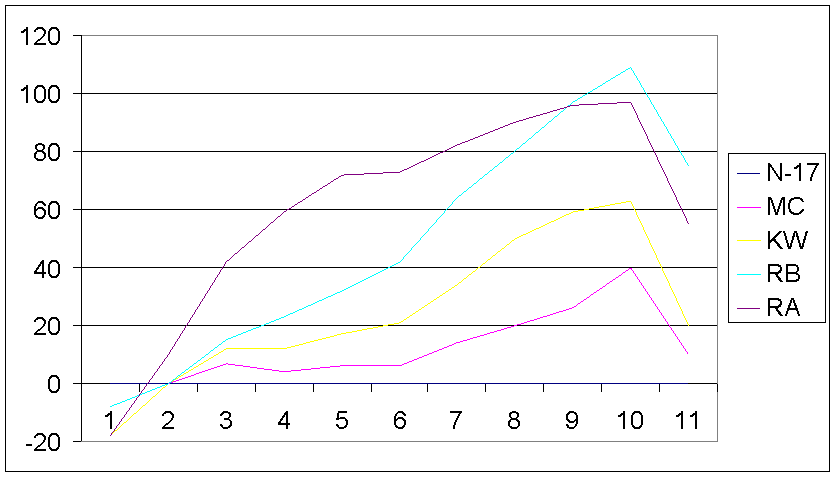
Nissan part numbers for some carb items:
These parts are available through Nissan as of the last time I checked. They often are not happy about looking them up. But, if you bring the numbers they will usually order them for you.
| Description | Part Number |
|---|---|
| Loose floats for 1600s and some 2000s | 16061-K1407 |
| 1600 manifold gasket | 14035-14611 |
| Carb Gasket kit, includes float bowl gasket | 16455-H2310 |
| Hinged floats for most 2000s and some 1600s | 16061-E4310 |
| N-17 metering needles, stock for 2000s | 16354-25611 |
| 2000 manifold gasket | 14035-25501 |
| Float bowl gasket only | 16064-22010 |
Here is the instruction sheet from the 240Z three screw Hitachi S.U. carb rebuild kit. This is most like the 2000 carbs. Some of the details vary from the Roadster carbs but the overall principles are the same. Of particular interest is the chart for setting the mixture knob for altitude and temperature. Also, for this carb they recommend 20w oil, the roadster uses 10w.


And that pretty much covers adjusting the SU carbs on a Datsun Roadster. They are a fairly simple design and pretty rock solid once dialed in. Thanks to Keith for sharing his expertise.
